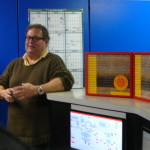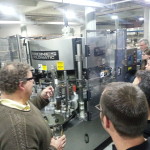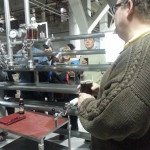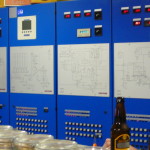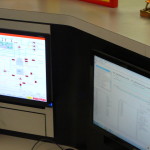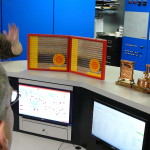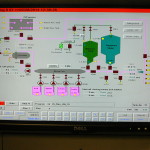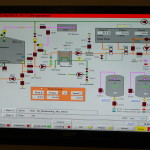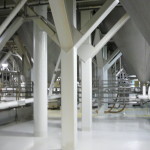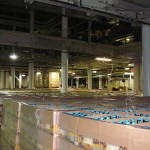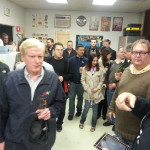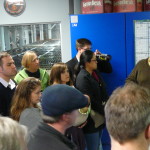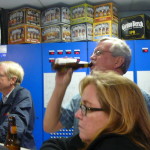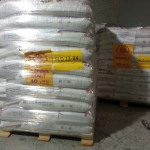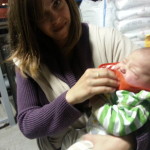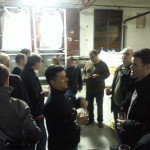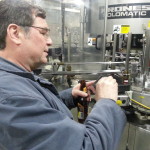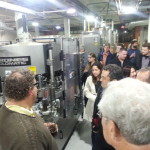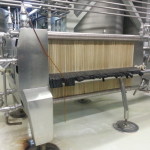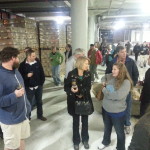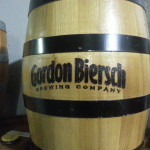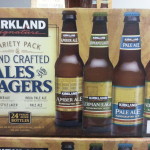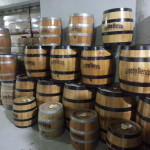Dan Gordon is amazing. His knowledge of not only beer, but every aspect of beer processing is without equal. He spent many years in Germany learning about brewing and visiting hundreds of breweries. From that, he learned what to do, and also what not to do.
For example, most of the European breweries are hundreds of years old. As such, they have tons of legacy equipment that they are unwilling or unable to give up. Dan was determined from the outset, that Gordon Biersch would only consist of the latest, state of the art equipment, and more importantly, uniformity throughout the factory with identical equipment for every batch of beer that is brewed. All the fermenters are identical, same size, same manufacturer, as is everything else in the brewhouse. Everything is computer controlled from a “control room” that looks similar to a nuclear power plant. There are racks of industrial controllers with digital temperature and pressure gauges, run by custom programmable logic and embedded controllers. This interfaces to a master computer program, pc based (Windows 7) with 3 widescreen LCD monitors. The central one is the actual command center running the program. The other two on each side display graphical representations of every piece of equipment in the factory showing in real time their operational status. You can see what valves are open or closed, which pumps are actuated, the temperature of all the processing vessels, and tons of other things. With a few clicks of the keyboard, Dan can display every beer in the line and exactly what’s going on. The software was developed by NERB, a German company, which doesn’t have the market share of the top 2 or 3 companies that support the big, giant breweries with 24/7 support, but can offer more custom support for Dan’s requirement. Fluent in German, Dan uses German Windows and all the software user interfaces are all in German. On one wall, there was a 50” flat screen monitor, displaying process statistics of every batch of beer by style. While Dan was demonstrating all this from the control room, he invited all of us to help ourselves to bottles of beer from the fridge located next to the master control station.
From there, Dan guided us on a tour of the brewhouse production floor, which is massive, and so clean you could proverbially “eat off the floor”. With all this automation, there are very few employees. All the fermenters and other equipment are connected to what I would call a “bus” such that any vessel can be connected to any drain or other pump. Some of this requires manual intervention, but it is kept to a minimum. At one point, there is a beer tap on a line directly out of the fermentation tank, with a sign-off sheet. Each of the 8 or 10 brewers has to sample each batch of beer and approve it before release. This is where there was a cart full of pint glasses which he filled and handed out to each person on the tour to sample the beer connected. Dan knows every detail of every piece of equipment from each valve, each pressure regulator, and something he was very proud of, a huge filter used in most of the beers, which he bought in Europe and shipped over here.
Gordon Biersch uses all German grains, with a few different malts. They buy something like 40,000 lbs at a time, shipped by train for lowest cost. Because the last few miles of delivery are much more expensive, all the grain is delivered to someplace around Tracy. From there it is transferred to trucks for delivery to the factory. The grain silos hold 60,000 lbs, so there is always a 50% buffer before the new shipment arrives.
As you would expect from a German brewery, they don’t use a lot of hops. It’s all in the malt. So they take extreme care on handling the grain. All the transfer pumps operate at low pressure so as not to damage the husks. Then the grain is pre-treated before use in three different ways. One is a traditional method of soaking it in warm water. Another method is to just spray it with warm water, then gently run it through a press to squish out the enzymes. I don’t remember the third method.
The hops are all German or European variety, about seven different kinds. IBU’s run in the low teens, except maybe the newest Pale Ale, the first ale they have made to complement all the lagers. I noticed this is included in the new variety pack they were packing for Costco under the Kirkland brand.
The bottling equipment was equally impressive, exclusively using machines made by Krones from Europe. They buy all the bottles pre-packed in cases where the automated machinery extracts rows of bottles, fills them, purges the oxygen, caps them, applies the labels, and places them back in their cases. Otherwise, they fill 15g and 5g Sanke kegs, cleaned by another automated line. Because Dan strictly adheres to reinheitsgebot, the German Beer Purity Law, he is careful not to add anything other than Hops, Malt, Yeast, and Water. This includes any chemicals like sanitizer, or line cleaner, or water softener. They do use cleaners, but they make sure it is steam cleaned and purged with water before any beer comes in contact. And they do treat the water, but without any chemicals.
As with most brewers, cleanliness is of prime importance. Once a week, all the equipment goes through a “CIP”, or cleaning in process, again, all automated. When they clean certain valves and connectors, they completely tear them apart to clean every component. Dan made a point of telling us about all the welding joints in the liquid lines. After firing several welders that were unable to deliver the quality he demanded by bore scope inspections, they finally paid a welder three times as much that was able to create smooth welding joints inside the pipes. The reason is that normal welding leaves excess material at the joint that can collect contaminants which are nearly impossible to clean properly.
The last part of the tour was the lab, located in the extreme upper corner of the factory, a peaceful place with windows, far from the production equipment. Here there were many small flasks lined up with filter papers in each one, ready to the next day’s work. Again, Dan knows every piece of equipment in this room, including a couple of expensive measurement instruments which he was proud to show off.
Finally, on the way out, Dan handed out six packs of the Blonde Bock, which happens to be my favorite Gordon Biersch brew, and Dan says it’s his, too. I have to say, Dan is a walking encyclopedia of beer. Listening to him talk about brewing is like taking a 6 week crash course in brewing compressed to a 20 minute talk. There isn’t one aspect of brewing which he doesn’t have a wealth of information. For someone who is the founder and owner of a multi-million dollar operation with 35 restaurant breweries in the US, including Hawaii, and four in Taiwan, Dan is one of the most humble people you would meet. I also know him well as an accomplished jazz musician that plays trombone both at his own venues, but also with popular jazz bands that play at the annual San Jose Jazz Festival. And you can tell he loves his beer. The motto that is printed on their T-shirts and on the logo glassware is, “Never Trust a Skinny Brewer”.
